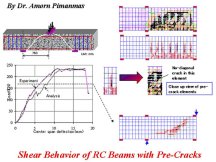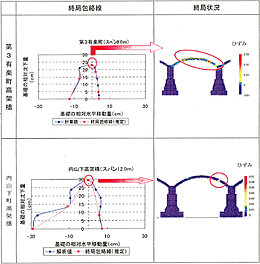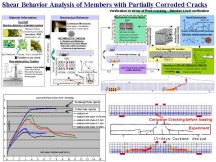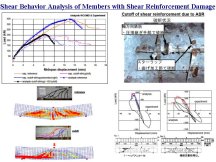 |
|
|
| üĪ |
Technical Support
|
|
|
| üĪ |
Technology
|
|
|
| üĪ |
Examples
|
|
|
| üĪ |
Theoretical Basis
|
|
|
|
|
|
Estimation of Damaged Structure
Structural analysis has so far been developed considering applying to newly constructed structures as a main purpose. In that case, generally that initial damage is suppressed below at the grade which can be ignored exists as a precondition.
However, the requests which apply structural analysis also to performance estimation of the existing structures or repair/retrofitting investigation have mounted from the earthquake disaster experience by big earthquakes, such as the Hyogo-ken Nambe Earthquake, and the conditions where infrastructure establishments will see renewal time at a stretch tens of years after from the high economic growth period in Japan. For the existing structures, cracking, spalling, corrosion and deformation etc. may have occurred partially by the environmental action or external forces during a service period. Therefore, in order to evaluate response behavior of the existing structures with sufficient accuracy, these damage conditions, such as cracks and deformation, have to be taken into consideration.
The plate model considering loading paths faithfully and multi-directional cracks up to four directions, which is the basis of this analytical method, is thought to hide possibility that it can become a very effective tool. It is actually recognized that this analytical method can evaluate shear response behavior of RC beams which has not only initial stress but also precedence cracks at arbitrary angles for every part with sufficient accuracy in a research level 1)-3). |
|
 Picture will be expanded when it is clicked. |
|
|
|
COMS Engineering Corporation propose expanding this analytical method and utilizing for performance estimation of the existing structures or investigation of repair or retrofitting. We think that very effective information can be offered when performing an engineering judgment by carrying out numerical analysis based on a detailed model. (Of course, the existing members and the newly added members/materials are modeled in consideration of stress condition etc., and input conditions are provided.) |
|
 Picture will be expanded when it is clicked. |
|
|
|
For example, the above figure is an illustration which made the analytical result one dicision material when countermeasures to the differential settlement of brick elevated bridges, which has passed about 100 years since service start, is investigated4).
In addition, this analytical method produces satisfactory results to the load resistant mechanism assessment of beam members with reinforcing bars corrosion generated partially and cracks accompanying its expansion, or insufficient anchorage (including deterioration), too5)-7)etc..
While the case which the bending anchorage part of shear reinforcement ruptures by expansion due to alkali-silica aggregate reaction is recently reported in Japan, for example, COM3 and WCOMD were promptly applied to the evaluation of residual capacity and performance of real structures which became anchorage defectiveness, and it were also introduced in press, such as NHK, in April 2003.
 ü@ ü@

Pictures will be expanded when they are clicked.
References
| 1) |
Pimanmas, A. and Maekawa, K. : Numerical simulation of failure path formulation and crack sequence in RC with full and local shear anisotropy, Proc. of JSCE, V-52, No.683, pp.157-171, August 2001. |
|
| 2) |
Pimanmas, A. and Maekawa, K. : Control of crack localization and formation of failure path in RC members containing artificial crack device, Proc. of JSCE, V-52, No.683, pp.173-186, August 2001. |
|
| 3) |
Pimanmas, A. and Maekawa, K. : Shear failure of RC members subjected to pre-cracks and combined axial tension and shear, Proc. of JSCE, V-53, No.690, pp.159-174, November 2001. |
|
| 4) |
Takahiro KANNO, Junichi KINO, Keiichi KOBAYASHI, Ikuo OGIWARA and Tokiharu HURUYA : Numerical Simulation of the Influence of Dirrerential Settlement and Seismic Performance of Tokyo Brick Elevated Bridge, SED, No.17, pp.96-109, JR EAST, December 2001. (in Japanese) |
|
| 5) |
Kukrit TOONGOENTHONG and Koichi MAEKAWA : Shear Capacity of Damaged RC Beam with Partial Longitudinal Cracks in Space, Proc. of JCI, Vol.26, JCI, July 2004. |
|
| 6) |
Kukrit TOONGOENTHONG and Koichi MAEKAWA : Unified FEM Computaional Approach for Material Expansion inside RC due to Reinforcement Corrosion and ASR, CONSEC '04, June 2004. |
|
| 7) |
Koichi MAEKAWA, Hikaru NAKAMURA, Yasuhiko SATO and Kukrit TOONGOENTHONG : The Influence of Insufficient Anchorage of Web Reinforcement to Shear Capacity of RC Beams, Proc. of JCI, Vol.26, JCI, July 2004. (in Japanese) |
|
|